McLeod Road Traditional 24-25
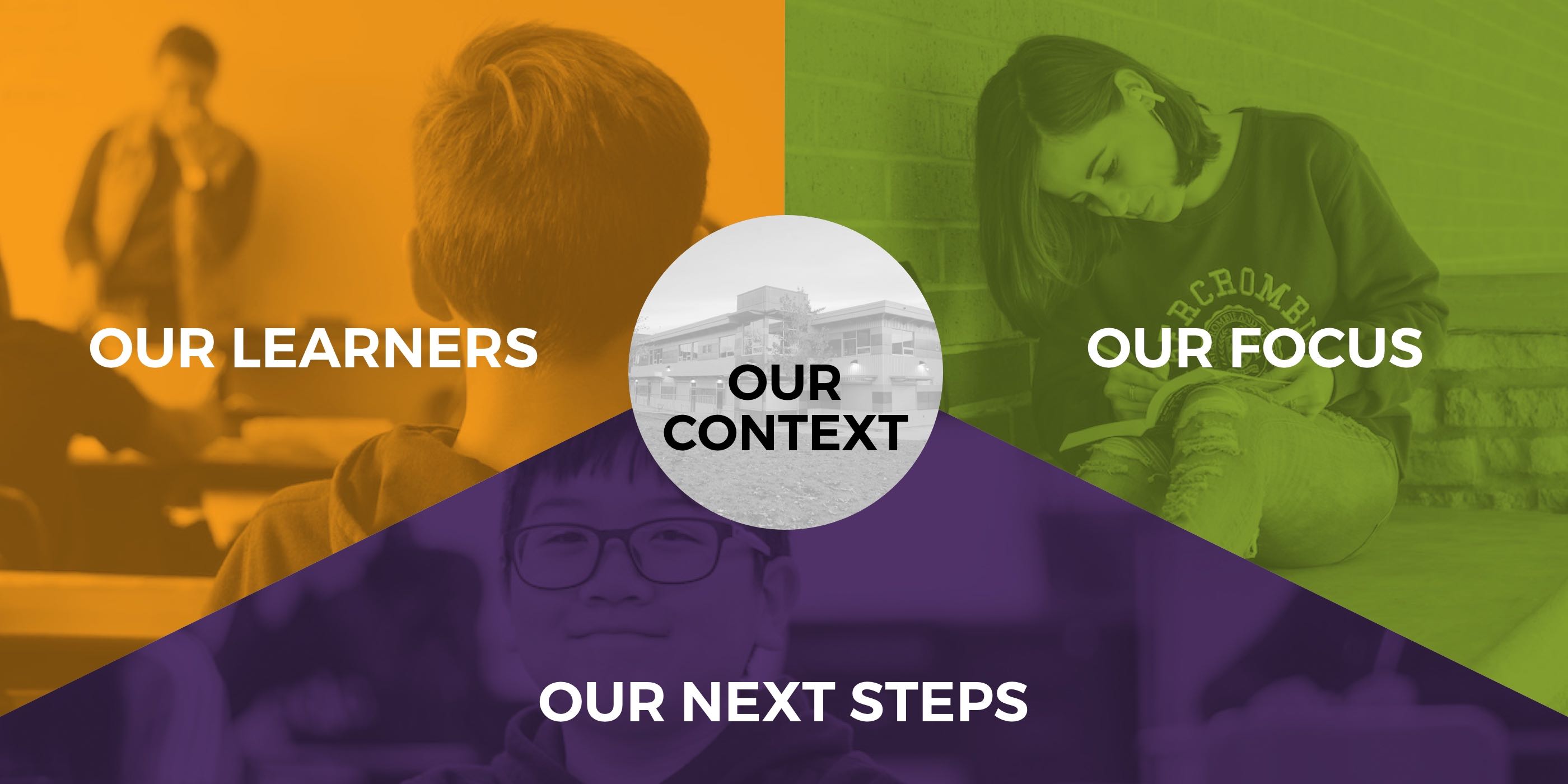

OUR CONTEXT
What is our school context?
McLeod Road Traditional Elementary School is proud to sit on the unceded, traditional territory of the Katzie, Kwantlen, and Semiahmoo First Nations and other Coast Salish Peoples. We are grateful to come to school each day to work and learn in this beautiful place. We are committed to learning about this place and we are learning to be stewards of the land.
The photo below is of the duck pond adjacent to the school property. Many classes walk to the pond to connect to place and to conduct scientific observations and experiments.

McLeod Road Traditional, also known as MRT, is a distinctive and close-knit educational community within the Surrey School District. The emphasis on a traditional learning experience, along with the unique aspects such as a school uniform, contribute to the school's distinctive culture.
The smaller size of the school fosters a keen sense of community and belonging among students, creating a unique and supportive learning environment. The stability of the community with returning staff and families, enhances the sense of trust and connection between all members.
The choice program's popularity among parents suggests that MRT offers something special that appeals to families seeking a more traditional educational approach. The pride students take in wearing their uniforms also reflects a shared identity and a sense of belonging.
Overall, the school context highlights the positive aspects of MRT, emphasizing its unique culture, community spirit, and the enduring relationships among students, staff, and parents.
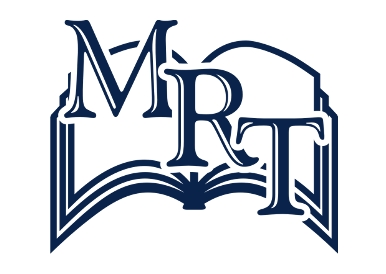
The parent community at MRT is supportive and respectful of the work we do at school. There is a robust Parent Advisory Council (PAC) who sponsor events such as hot lunches, treat days, special events and a school-wide pancake breakfast. We value the partnership with our parent community. It is critical to work together to ensure that all students reach their full potential.
Even though students come from all over Surrey to attend our school... we feel like a family!
OUR LEARNERS
Who are our learners?
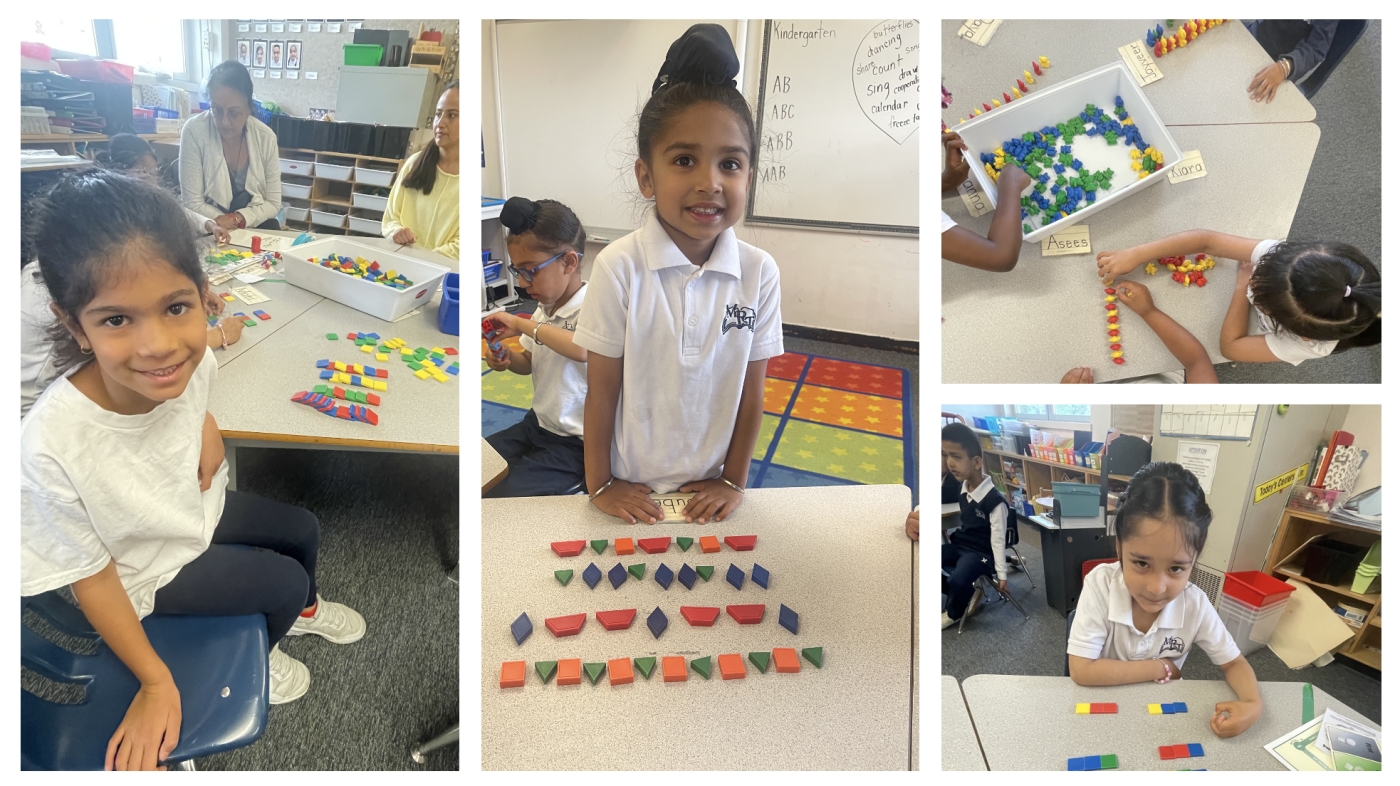
Mrs. K says, "Patterning is a fun way to experience math in a hands-on way. The students don't even realize that they are building the foundation needed to learn algebra ."
McLeod Road Traditional School serves a student body of 210 learners distributed across nine classes, creating a close-knit learning community. The more traditional approach to learning, which focuses on unity, discipline, and respect, creates a tendency to have more structured classrooms and more teacher directed instruction. The families of these students place a high value on education, which is evident in the students’ dedication to learning and their pride in academic achievement.
A significant characteristic of the student population is its linguistic and cultural diversity—most students speak a second language at home, enriching the school community with a variety of perspectives and experiences.
Top languages spoken at home based on student enrolment:
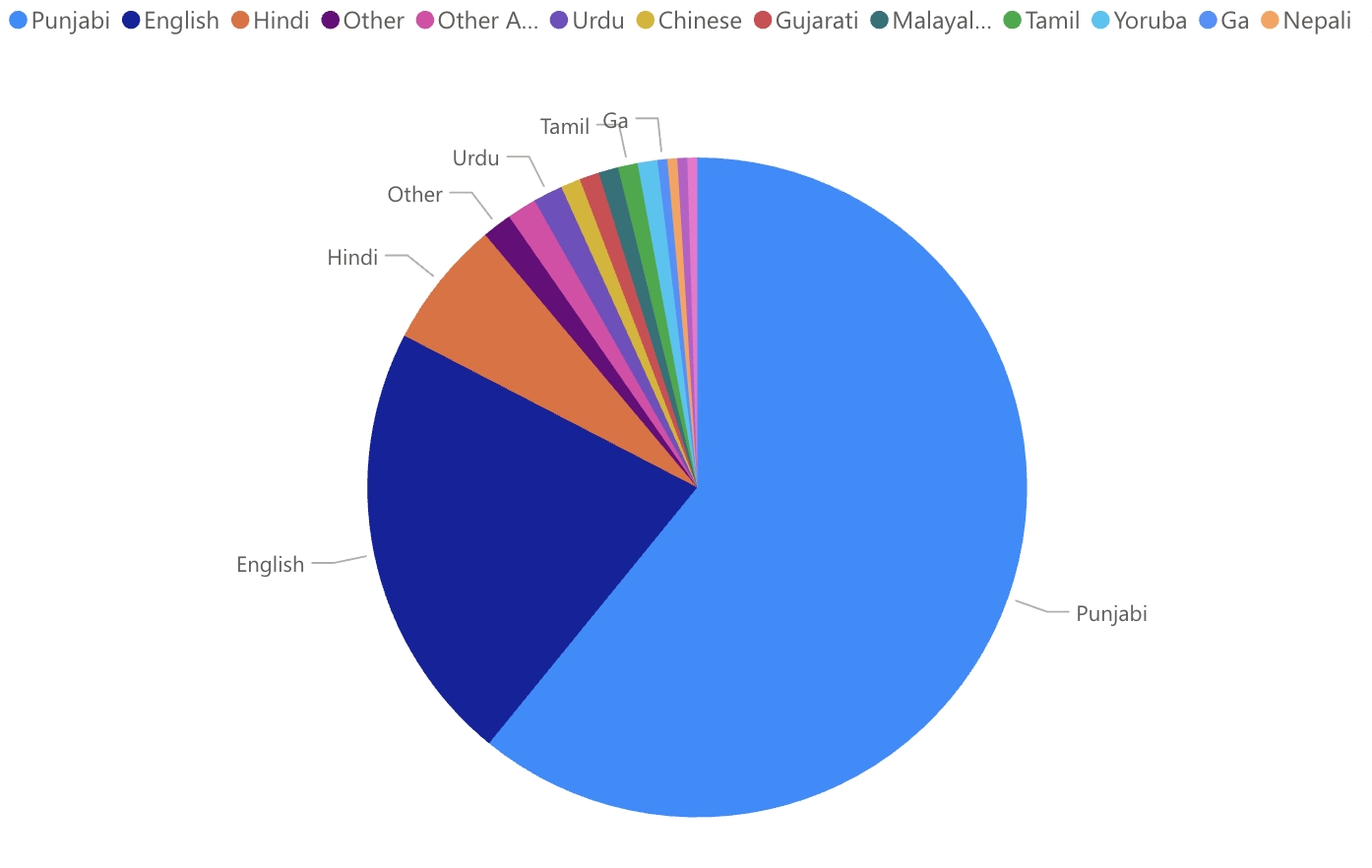
As is the case at every school, there are learning strengths and challenges. Many students excel in rote learning and fact recall, showing strong memory skills and the ability to retain and reproduce information accurately. However, when it comes to higher-order thinking skills—such as analysis, synthesis, and evaluation—the students tend to face more challenges. This has become clear when looking at the Foundational Skill Assessment (FSA) results of the students in grade 4 and grade 7.
This suggests an opportunity for the school to further develop instructional strategies that promote critical thinking, problem-solving, and creativity in the area of numeracy.
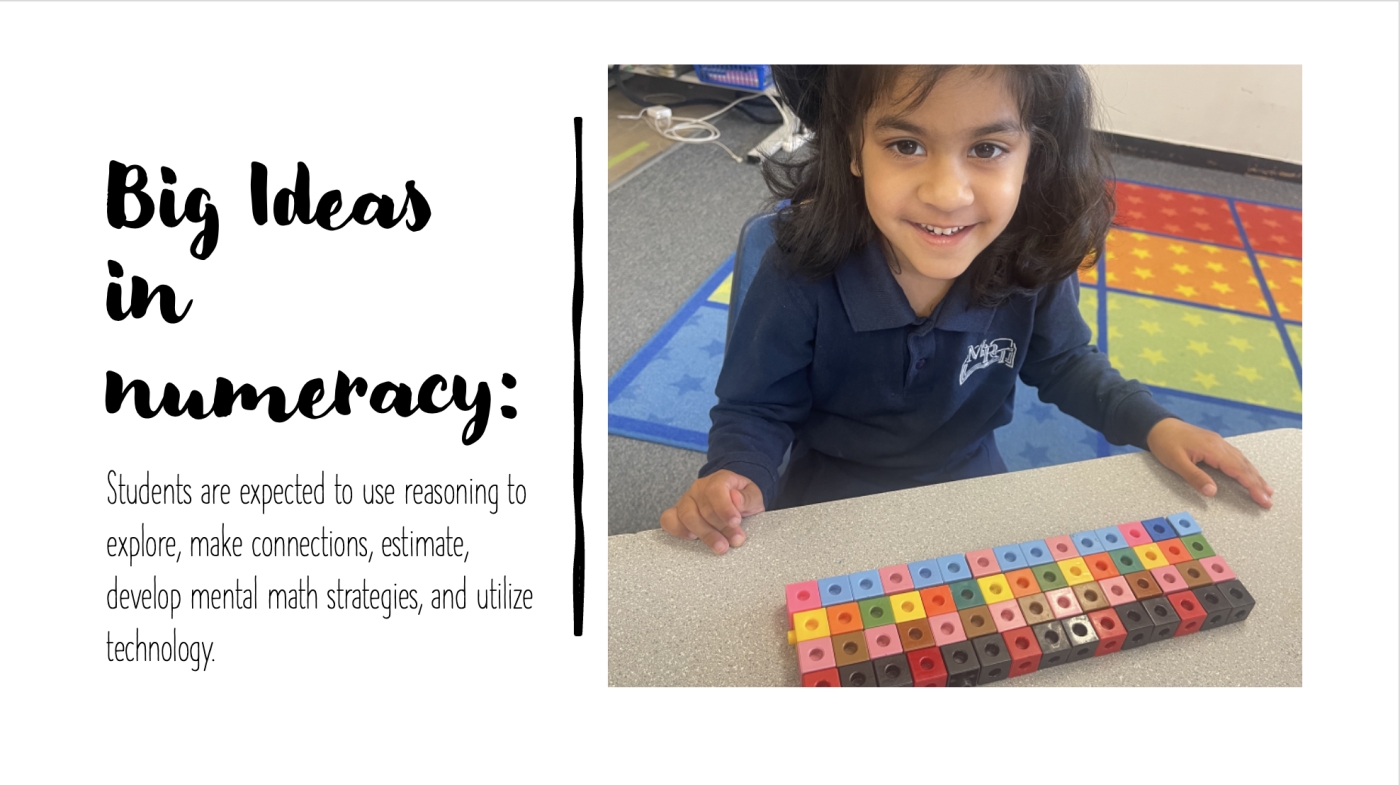
OUR FOCUS
Why have we selected numeracy as a school focus?
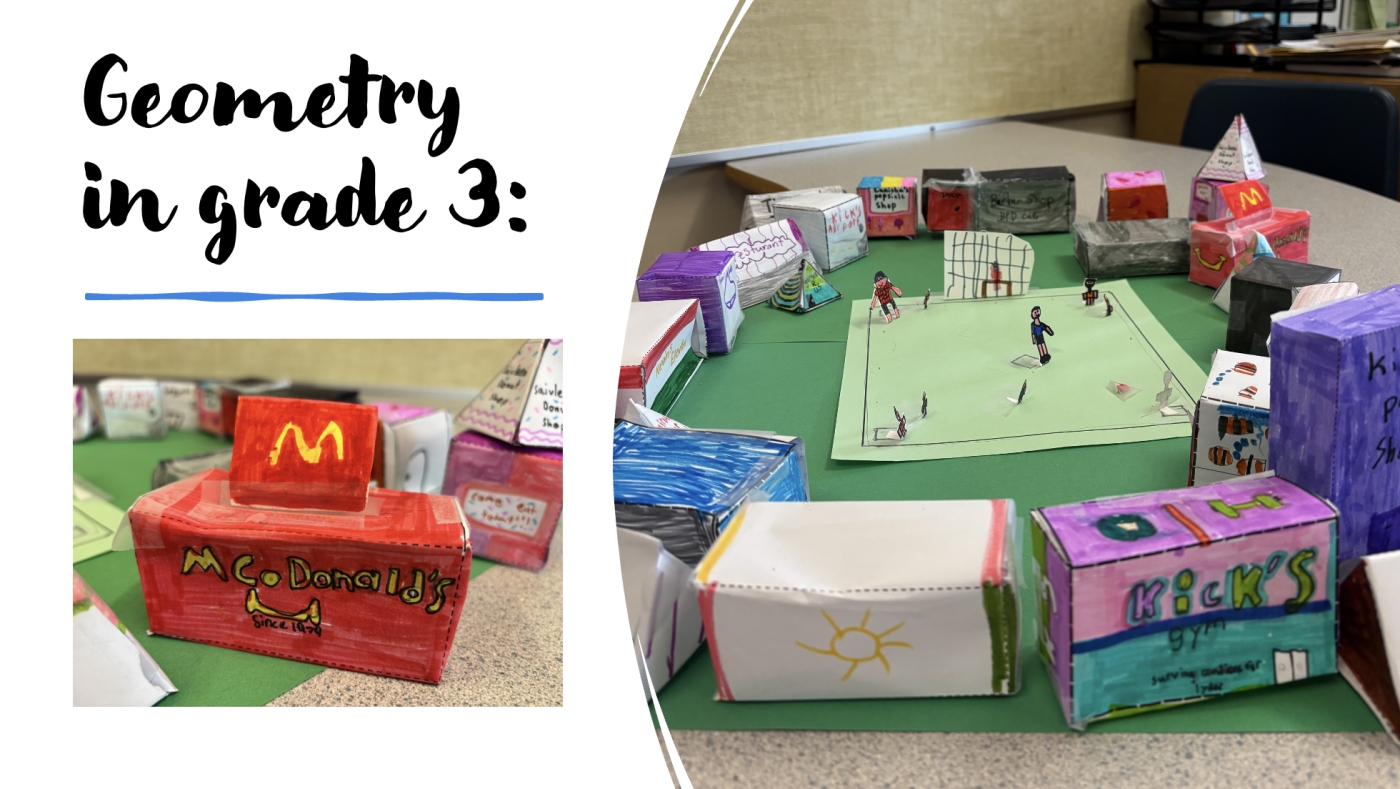
Mrs. W explains "the students were able to explore their creativity by combining math and art. Students were creating buildings based on their "net" shape."
At McLeod Road Traditional, we are committed to fostering academic excellence and supporting every student’s growth. After a careful review of recent Foundation Skills Assessment (FSA) results, it has become clear that numeracy is an area where our students would benefit from targeted support and development.
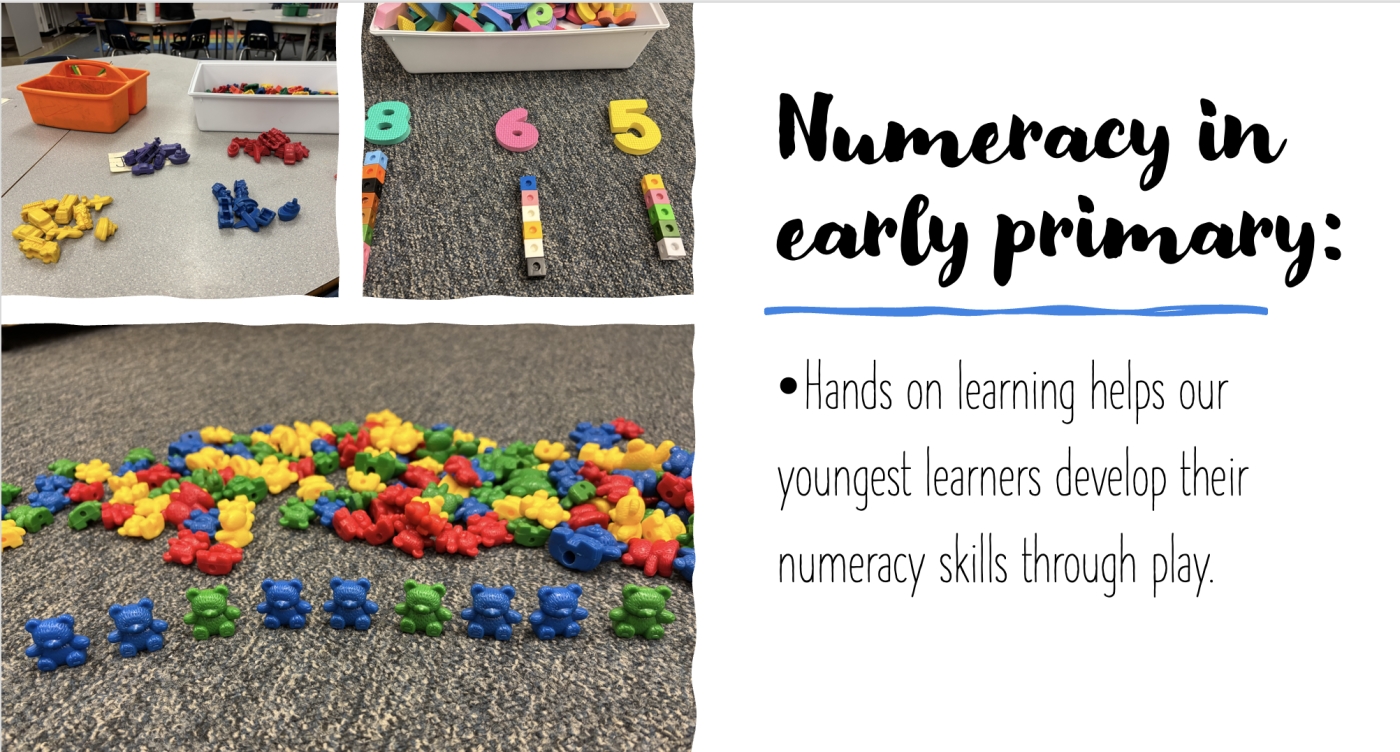
While many of our students demonstrate strong foundational skills—such as fact recall and basic computational math—they often encounter challenges when faced with more complex or unfamiliar mathematical problems. This suggests a need to strengthen their flexibility of thinking and deepen their conceptual understanding of mathematics.
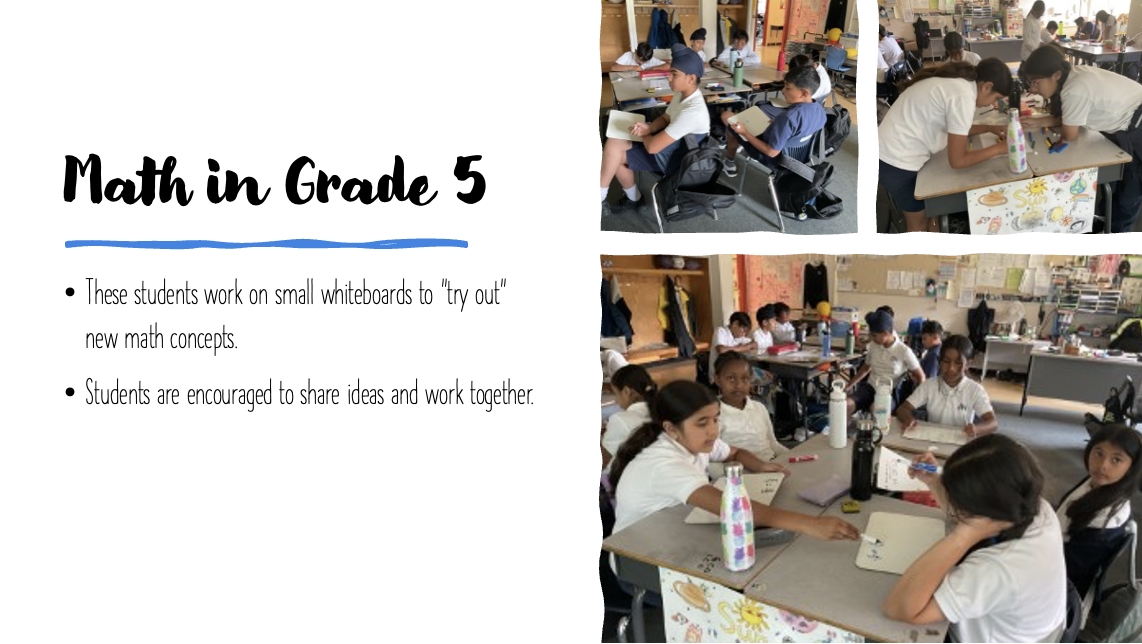
Mr. P explained that, "A different medium (whiteboards) allows students to "draw" their thinking while they are learning new concepts in math. It is less intimidating to make a mistake on a whiteboard that can be easily be erased versus writing it on a paper or in a notebook. It also encourages sharing between students and allows for easy formative assessment ."
Our FSA data indicates that there is a school-wide opportunity to enhance overall math proficiency. Specifically, students need to build stronger problem-solving strategies and develop a growth mindset. When math becomes challenging, we want our students to feel confident in their ability to persevere, explore different approaches, and learn from mistakes.

What are we noticing in the grade 4 data?
•Most grade 4 students are on track for literacy and numeracy.
•More children are emerging in their numeracy skills than in literacy skills.
•More children are extending in literacy than in numeracy.

What does the grade 7 data tell us?
•Most grade 7 students were marked as on track for literacy
•No one was marked as emerging in literacy.
•Quite a number of students were marked as emerging in numeracy.
•There are also more students marked as extending in numeracy than in literacy.
This data makes us wonder about the students who are emerging in their mathematical ability. It seems that many students are learning and progressing well with the classroom teaching and extra supports that they are given but what about the students who are not making the expected progress. How do we meet their needs in order to help them achieve success?
Although students generally enjoy math and express positive attitudes toward the subject, as seen in the student collected data below, there is room for growth in this core academic area. The grade 5 students surveyed fellow students to see what their school favourite subject was. Overwhelmingly, the male identifying students selected math as their favourite subject with language arts and science a distant second and third respectively. The female identifying students also selected math as their favourite subject but language arts was a close second place.
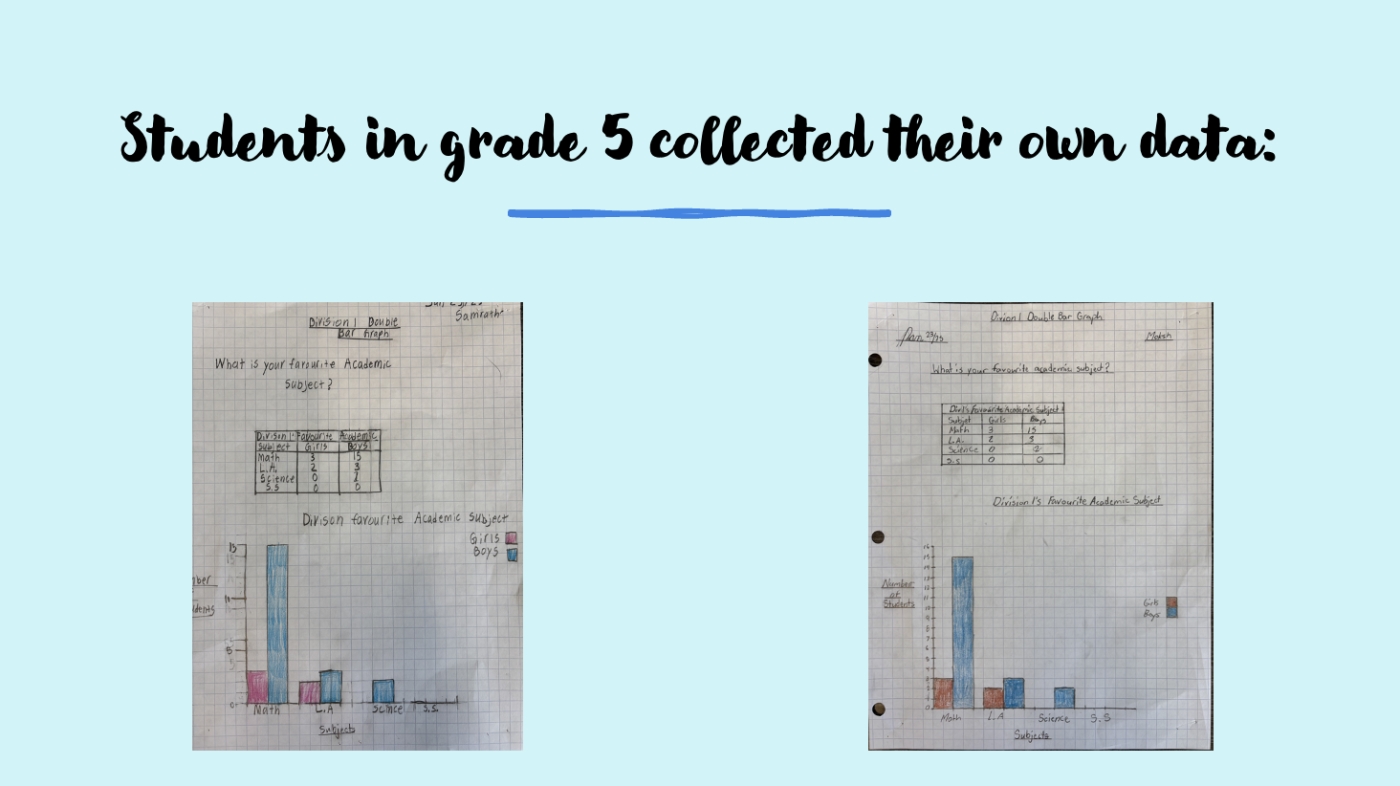
By focusing on numeracy as a school goal, we aim to:
- Support students in becoming more adaptable and strategic thinkers in math.
- Encourage resilience and a positive mindset when tackling difficult problems.
- Improve overall student achievement in numeracy, as reflected in future FSA results and classroom assessments.
This goal aligns with our broader mission to equip students with the skills they need to succeed not only in school but in life beyond the classroom.
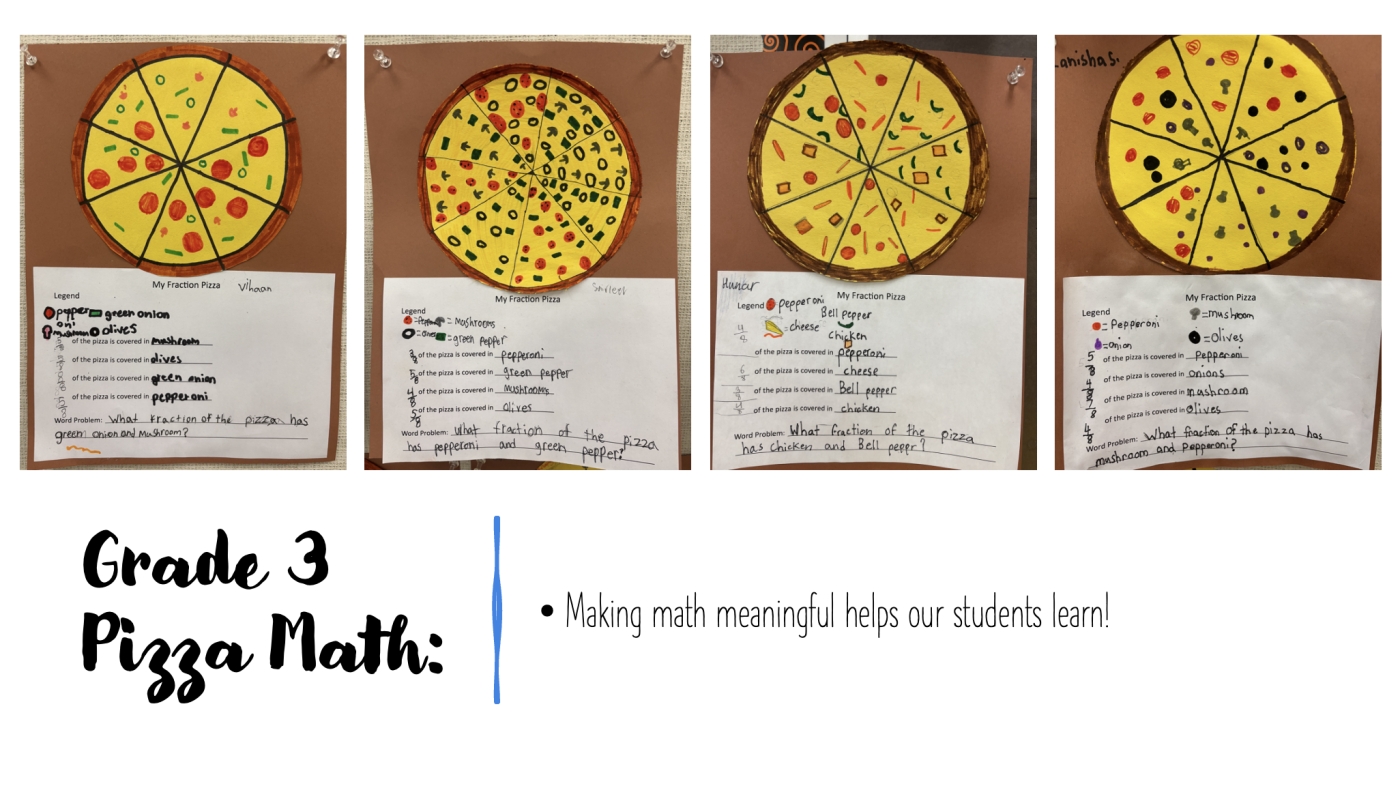
The teacher explained that this activity was designed to connect math concepts to the real world. Everyone loves pizza!
OUR NEXT STEPS
What have we learned and where will we go next?
To effectively track student progress in mathematics over time, we will utilize a multi-faceted approach that combines classroom teacher assessments, proficiency scale data from student reports, and information on students receiving targeted numeracy support. Classroom teachers will conduct regular formative and summative assessments aligned with curriculum standards, providing ongoing insights into individual student understanding and skill development. These results will be complemented by proficiency scale data from formal reporting periods, offering a standardized measure of student achievement across key mathematical domains. Additionally, we will monitor the number of students receiving specialized numeracy support, which will help identify trends in learning needs and the impact of interventions. Together, these data sources will enable us to build a comprehensive picture of student growth, inform instructional planning, and ensure timely support for those requiring additional help.
Term 1 Proficiency Scale Data for Grade 4:
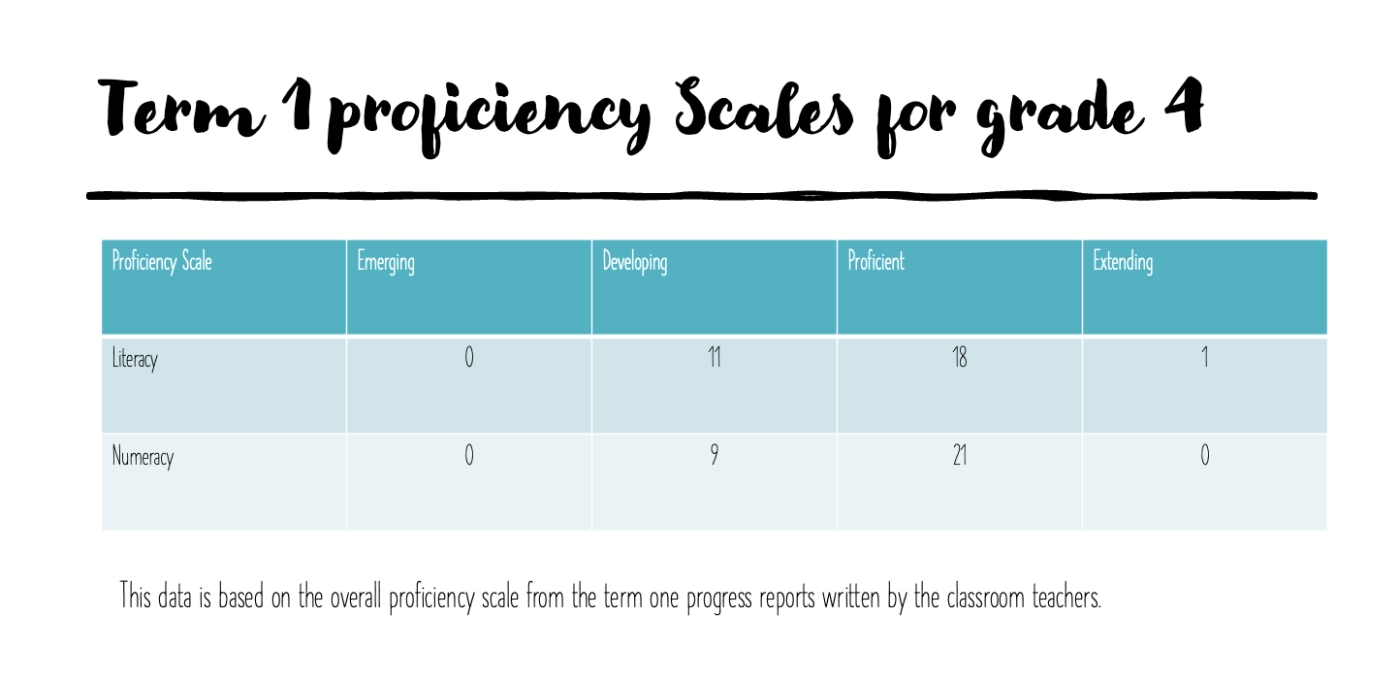
In their term one reports, there were no grade 4 students who were emerging in numeracy. A number of students were still at the developing level while the majority of the students were at the proficient level. There were no students who were reported to be extending in their numeracy skills.
This poses the question, why are some students getting an emerging level in the province wide FSA assessment but they are doing better in their classroom assessments.
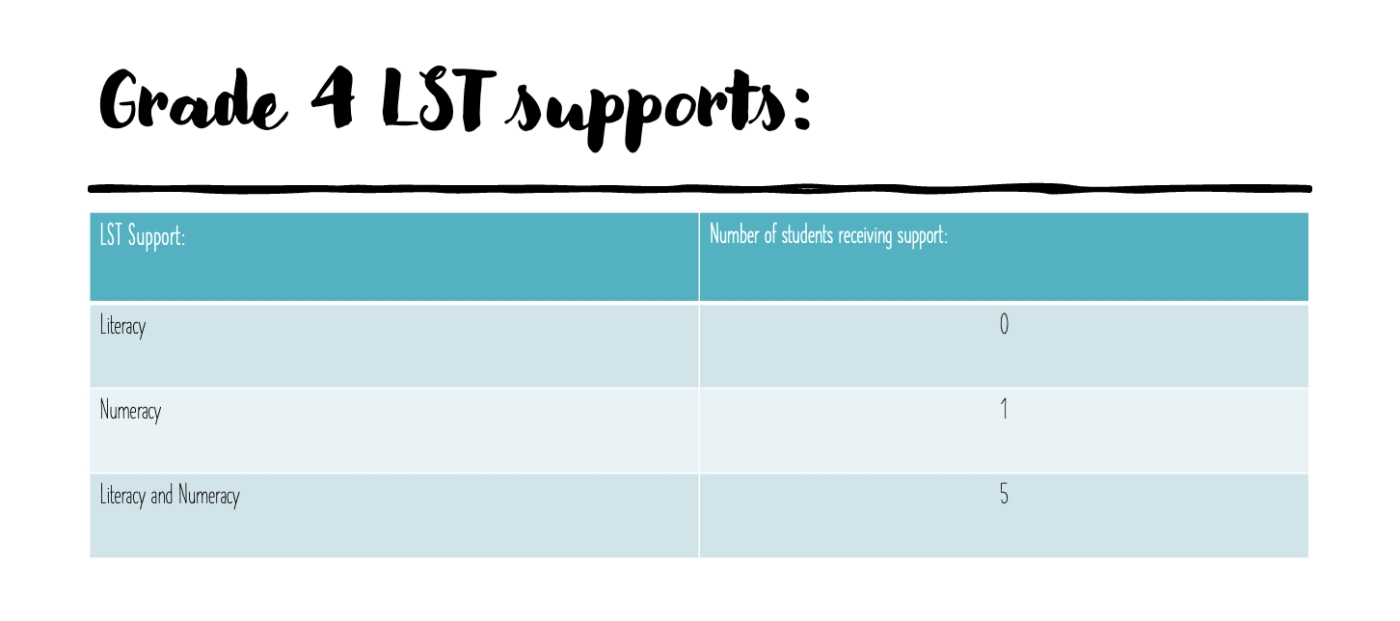
On this chart, you can see that one student in grade 4 is receiving extra support for numeracy only while five student are receiving support for both literacy and numeracy.
Term 3 Proficiency Scale Date and LST Support Data for Grade 4:
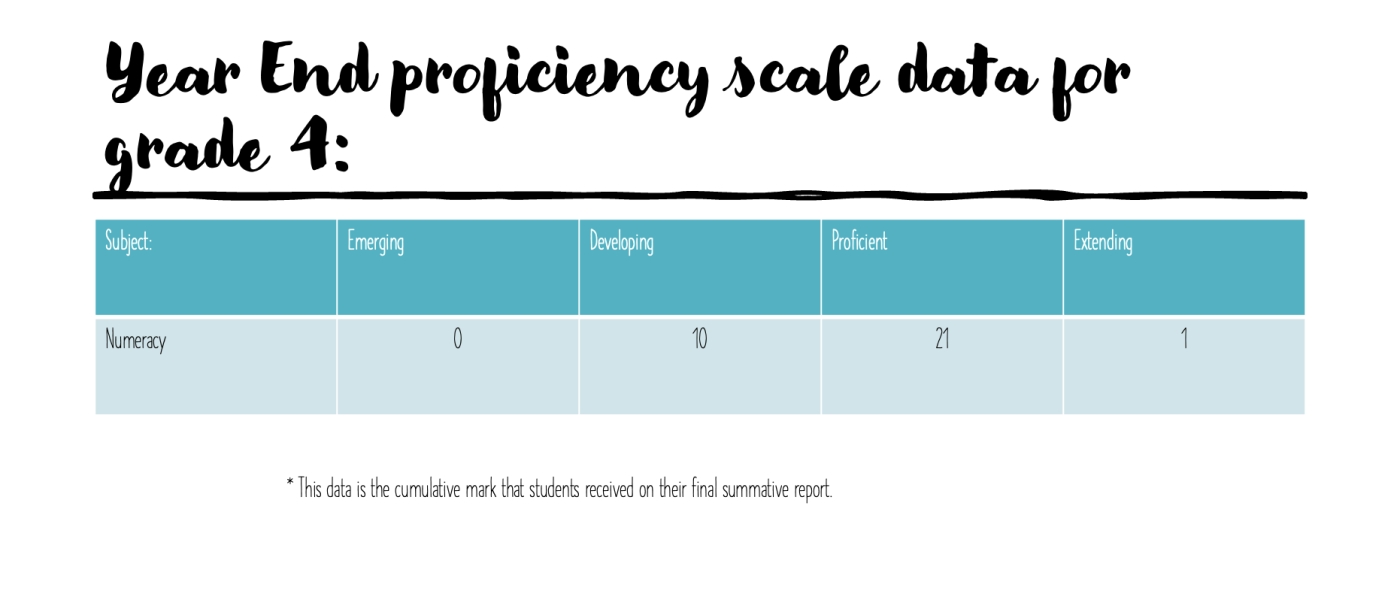
When looking at the summative data for classroom assessment, you can see that there is very little change from the term one proficiency scale data. There are two more students who have been included in the data. There is one more student in the developing category. The same number of students are marked as proficient. One student now has met the criteria for extending in numeracy.
Term 1 Data from the Grade 7 Class:
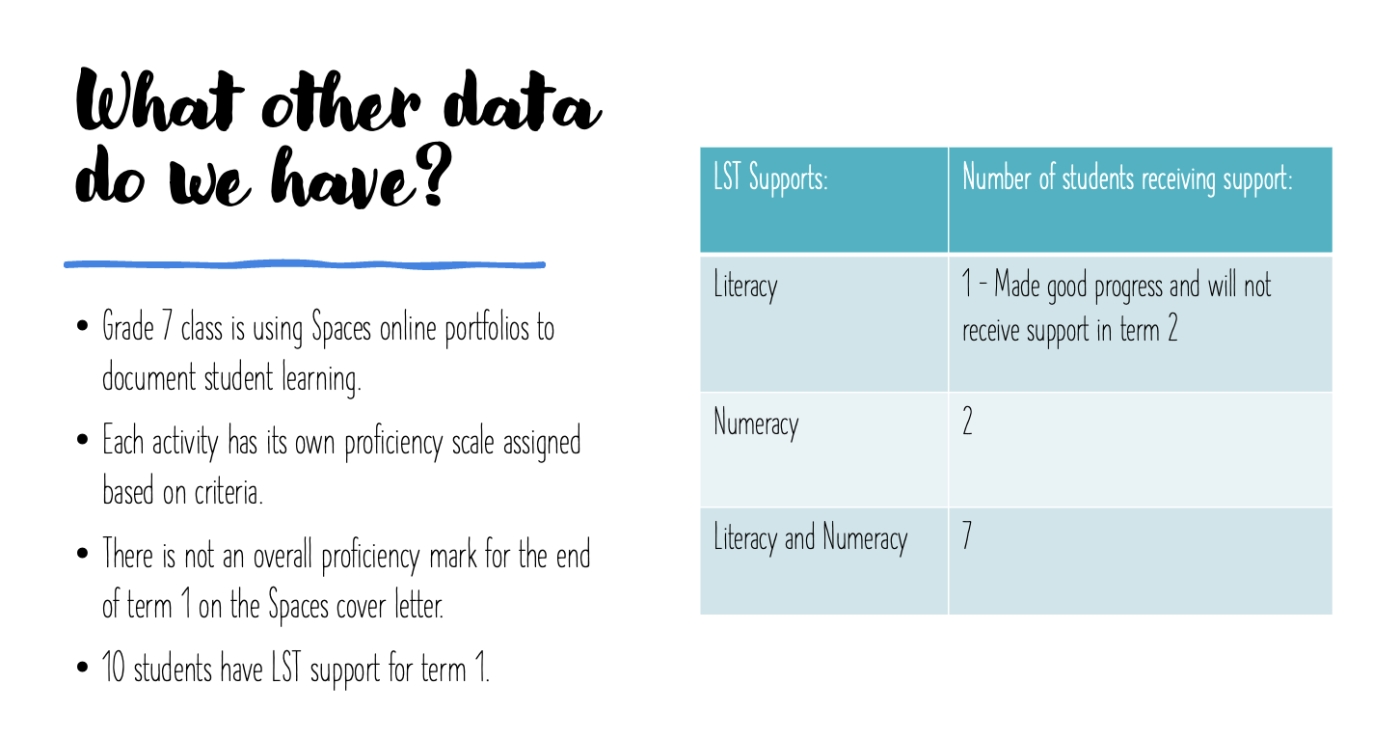
Term 3 Data from Grade 7:
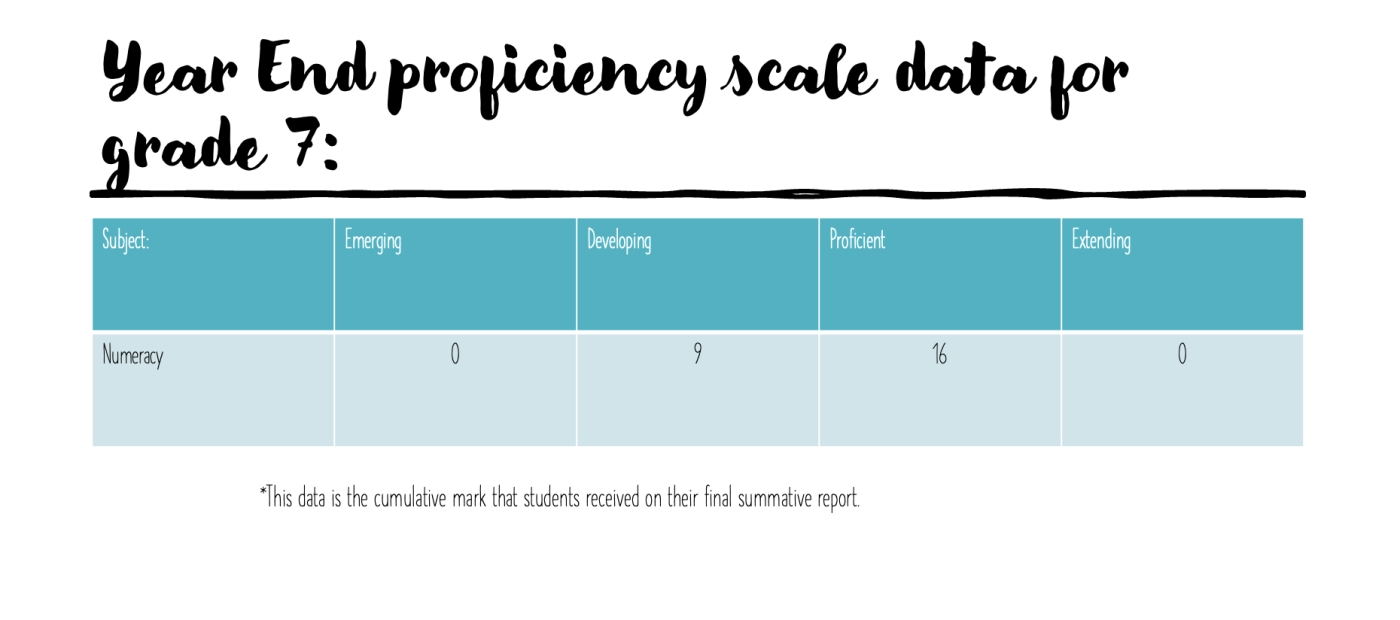
From the data above, we can see that most students are proficient in numeracy with many students falling into the developing category. No one in grade seven received an emerging mark or an extending mark.
Where do we go next?

The data collected this year is a starting point but it creates some "wonders" for our staff such as:
- Why are some students developing or proficient in their classroom assessments but receiving emerging or extending results in the provincial FSA assessment?
- How can we support our learners to become more flexible math thinkers?
- Why are none of our grade 7 students and only one of our grade 4 students receiving an extending mark in their summative report?
- Are we assessing the same types of skills in the classroom assessment compared to the provincial FSA?
As educators, it is our job to stay reflective and reflexive. We will continue to examine our practice to ensure that we are meeting the needs of all learners to the best of our ability.
"Mathematics is not about numbers, equations, computations, or algorithms: it is about understanding." - William Paul Thurston
